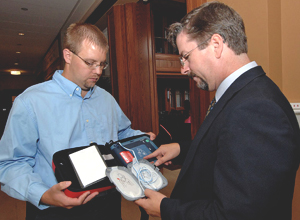Washington University installed automatic external defibrillators (AEDs) in seven areas across the Danforth Campus Sept. 16 with a high volume of foot traffic.
An AED is a computerized medical device that can monitor a person’s heart rhythm and can recognize when a distressed person requires a shock to re-establish a normal heart rhythm.
It uses photos, voice prompts, lights and text messages to tell a rescuer if a shock is needed and what steps to take to administer the shock.
AEDs were installed in the following areas Sept. 16:
- Danforth University Center;
- Mallinckrodt Center;
- Mildred Lane Kemper Art Museum;
- Olin Library;
- South 40 House;
- Village House; and
- Whittemore House.
The AEDs are located in metal cabinets with glass windows and are clearly marked.

David Kilper
Mark Bagby (left), emergency management coordinator, and Matt Arthur, director of incident communications solutions, examine an AED at the Danforth University Center.
“A person can have a medical emergency at any time, and, sometimes, minutes or seconds can be the difference in saving a life,” says Mark Bagby, emergency management coordinator.
“The university deployed AEDs to seven high-occupancy buildings, and having AEDs close by those areas in case of an emergency provides another layer of safety for the university community,” Bagby says.
At each location, at least two staff members typically stationed near the location will receive training on how to operate the device and perform CPR.
AEDs already were in place in the Athletic Complex, Simon Hall, Knight Center, WUPD Patrol Cars and EST Response vehicles, and also in North Campus and West Campus.
For more information about AED locations or other emergency preparedness measures on campus, e-mail Bagby at bagbym@wustl.edu.